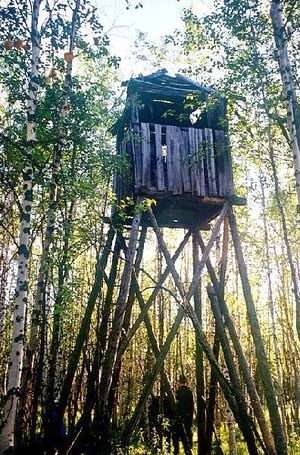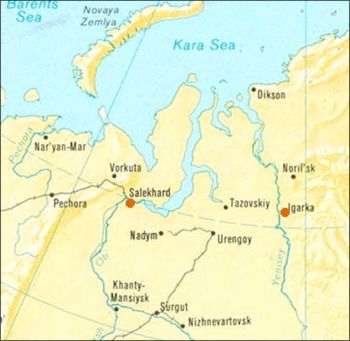Salekhard-Igarka Railway
The Salekhard-Igarka Railway, referred to variously as Railroad of Death, Road of Death, and Dead Road, was a project of the Soviet Gulag system that took place from 1949 to 1953. It was part of a grand design of Josef Stalin to span a railroad across northern Siberia to reach the Soviet Union's easternmost territories. The connection from Igarka to Salekhard measured 806 miles (1297 km) in length. The project was built mostly with prisoner labor, particularly that of political prisoners, and thousands perished.[citation needed]
Purpose
The purpose of the railway was threefold: to facilitate export of nickel from neighboring Norilsk; to provide work for thousands of post-war prisoners; and to connect the deep-water seaports of Igarka and Salekhard with the western Russian railway network. With Soviet industry relocated to western Siberia during World War II, it was seen as a strategic advantage to use the northward-flowing river systems to deliver supplies to Arctic Ocean ports. Salekhard was on the Ob River, downstream from Novosibirsk and Omsk, and Igarka was on the Yenesei, which flowed north from Krasnoyarsk, Irkutsk, and even Lake Baikal.
History
Construction began in summer 1949 under the supervision of Col. V.A. Barabanov. The 501st Labor Camp began work eastward from Salekhard, while the 503rd Labor Camp pushed westward from Igarka. Plans called for a single railway line with 28 stations and 106 sidings. It was not feasible to span the 2.3 km Ob River crossing or the 1.6 km wide Yenesei River crossing. Ferries were used in the summer, while in the winter the trains spanned the river on ice with specially strengthened crossties.

It was estimated that anywhere from 80,000 to 120,000 laborers were engaged in the project. In the winter, construction was hampered by severe cold, permafrost, and food shortages. In the summer came bogged terrain, diseases, and the pestilence of mosquitoes, gnats, midges, and horseflies. On the technical side, engineering problems included construction across permafrost, a poor logistical system, and tight deadlines compounded by a severe lack of power machinery. As a result, railway embankments slowly settled into the marsh or were eroded by ponding. A shortage of materials also affected the project. One-meter segments of damaged rail lines from war-torn areas had to be sent in and re-welded to form 10-meter lengths.
As the project progressed, it became clear that there was actually little demand for this railway. In 1952 officials permitted a reduced tempo of work on the project. Construction was stopped in 1953 after Stalin's death. A total of 434 miles (699 km) of railway were completed at an official cost of 260 million rubles, later estimated to be near 42 billion 1953 rubles (2.5% of total Soviet capital investment at the time, or about $10 billion in 1950 dollars). The project was quickly destroyed by frost heaves and structural failures arising from underconstruction. At least 11 locomotives and 60,000 tons of metal were abandoned, and bridges have decayed or burned down. However, the corridor's telephone network remained in service until 1976.
About 350 km of track between Salekhard and Nadym remained in operation from the 1950s to the 1980s. However in 1990 the line was shut down, and due to rising steel prices the first 92 km of rail from Salekhard were dismantled and recycled during the 1990s.
Interestingly around the year 2000, discussion began about building a railway to Norilsk, about 220 km from Igarka, following much of the original corridor, to support the nickel and petroleum industry.
External links
| Wikimedia Commons has media related to: Transpolar railroad |
de:Polarkreiseisenbahn nl:Poolcirkel-spoorlijn ru:Трансполярная магистраль


